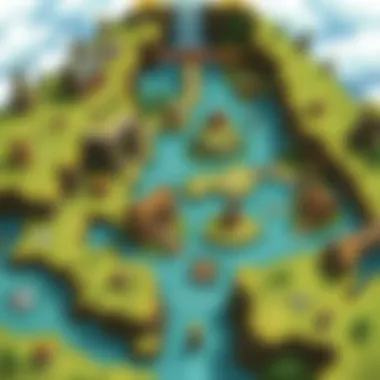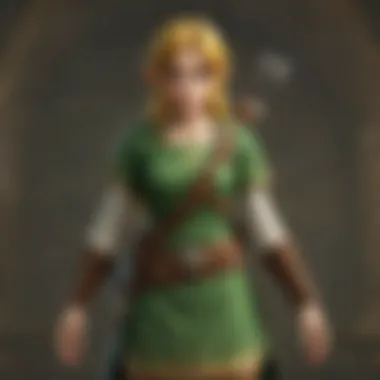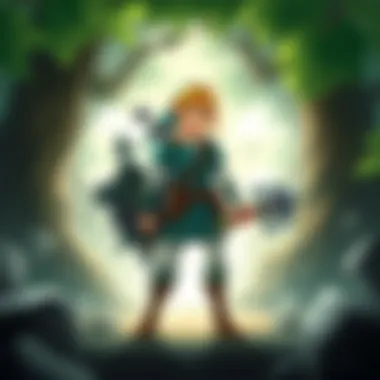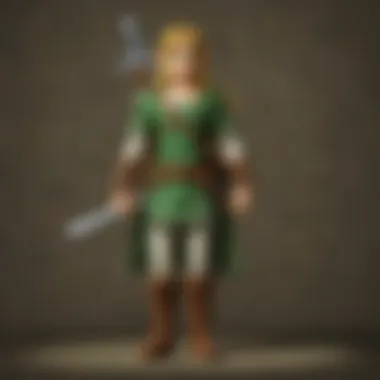Exploring the Depths of Hyrule: A Comprehensive Analysis of Zelda


Intro
The world of Hyrule is not just a backdrop for a video game; it is a well-crafted universe filled with intricate narratives, unique characters, and significant cultural impacts. This analysis delves into the myriad aspects that elevate The Legend of Zelda series beyond standard gameplay. The franchise invites both casual gamers and devoted fans to discover its landscapes, from the Forest of Time to the ominous depths of the Shadow Temple.
Exploration of gameplay elements reveals both mechanics and narratives. We will discuss character arcs that shape the emotional tone of the games. Lore discussions will engage with the rich mythology that makes the series both compelling and profound, offering theories and placing these adventures within a broader timeline. Readers will find insights into strategies that result in mastering the games, enhancing the overall experience. Prepare to venture into the often uncharted and fathomless waters of the Zelda universe, leaving no stone unturned.
Hope you enjoy the journey ahead.
Game Reviews
Prolusion to the Zelda Series
In examining the Zelda series, one must recognize its role within the gaming industry. This series serves not only as entertainment but as a cultural touchstone that has shaped the landscape of video gaming. The importance of understanding Zelda begins with its intricate narratives, distinctive gameplay, and a rich tapestry of characters. Through this article, we aim to highlight its historical context, gaming mechanics, and fan contributions, all while catering to both newcomers and established aficionados.
Historical Context of Zelda
The origin of the Zelda franchise dates back to 1986 when Shigeru Miyamoto and Takashi Tezuka collaborated to launch the first game: The Legend of Zelda. This groundbreaking title merged exploration with action-adventure gameplay. It introduced a non-linear format, giving players the freedom to navigate the world of Hyrule as they saw fit. This innovation paved the way for future games, offering a foundation that many other titles followed, thereby propelling the importance of the series into the mainstream.
Since its inception, Zelda has consistently reflected advancements in gaming technology and evolving design philosophies. Each installment showcases the creative ambitions of Nintendo, entrancing players with fresh concepts along with nostalgic elements. For example, the transition from 2D aesthetics in The Legend of Zelda: A Link to the Past to the stunning 3D realms in The Legend of Zelda: Ocarina of Time exemplified both technical evolution and deeper storytelling.
Significance in Gaming Culture
The Zelda series holds monumental significance in gaming culture, emerging as an exemplar of what is possible in interactive entertainment. Its influence extends into various domains affecting both casual gamers and dedicated enthusiasts.
Key points to consider:
- Crafting a Rich Narrative: The franchise elevates narrative structures by interweaving mythology with personal stories of courage and growth, setting itself apart from mere gameplay mechanics.
- Innovative Gameplay Mechanics: Zelda games often include puzzles that challenge norms, creating an experience where players must think critically and engage actively with the game world.
- Community Engagement: The impact of the community is noteworthy. Fan theories and artistic expressions contribute significantly, encouraging discussion and deeper understanding of the game's lore.
Nintendo did not just create games; they crafted universes, captivating audiences with .
Game Mechanics Overview
The exploration of game mechanics in the Zelda series is a critical focal point for understanding how the franchise achieves its lasting appeal and ear of enduring relevance. Central to many successful video games, game mechanics refer to the methods and systems implemented within the game to engage players and provide a rewarding experience.
In the emerging layout of Hyrule, these mechanics enable players to navigate, battle, and solve intricate puzzles. Here, we dissect several critical mechanics—growth, combat, and environmental interaction—that present nuanced gameplay experiences unique to the Zelda universe.
Gameplay Elements
Gameplay elements demonstrate the complexities and the richness of interaction within the Zelda games. Player agency and decision-making become pivotal as characters embark on quests intertwined with emotional stakes and engaging environments.
One defining feature is the core ability of the main character, Link, to use various tools and items to progress through mazes. Whether using boomerangs, bows, or bombs, players discover that each item carries specific tactical advantages.
Item distribution fosters a sense of progression as players explore Hyrule, unlocking capabilities gradually, enhancing skill development throughout the adventure.
Additionally, the gameplay is designed to express freedom. Link’s extensive exploration leads to an array of challenges, secrets, and tasks to determine the area. For example, in Breath of the Wild, players encounter a tiered climbing and gliding mechanic that allows varied approaches to reach objectives.
Maintaining engagement is crucial. Timed quests, combat sequences, and environmental storytelling blend together to involve the player deeply. The balance of challenge versus ability is finely crafted as players progress, guaranteeing that frustration remains prevented and reward remains ensured.
Puzzles and Challenges
Puzzles are intrinsic to the Zelda franchise; they emphasize cerebral engagement over mere button-mashing dexterity. Within numerous dungeons and locales, they beckon players to curate instinct and reason. Environmental puzzles often prompt manipulation of items in a spatial context or engagement with intricate rules reflected in the surroundings.
In titles like Ocarina of Time, various puzzles challenge players to draw upon intellect. Matching particular patterns opens pathways, while the use of items often coincides with the subtle integration of storytelling. Maintaining that guided exploration induces a rewarding experience. Key elements of the puzzles include:
- Interactivity with the environment: For instance, players might extinguish torches or collapse bridges creatively!
- Logical tests: These make players layer their prowess. It might culminate from combining elements like fire and ice to unlock mechanisms needed.
- Timed elements: Such ticking clock showcases each movement succinctly labeled as time constraints rise.


In essence, these multilayered challenges cultivate a deeper connection between the player, story, and even the very fabric of Hyrule itself. This solidifies Zelda’s status in the gaming arena and commands a legacy cherished by a multitude of followers and enthusiasts.
“Zelda isn’t just a game; it reflects our ability to problem-solve and face challenges. The moments of discovery alongside Link foster a personal bond that echo achieving mastery in real life.”
Overall, the mechanisms of gameplay evolve but reflect sound foundational strategies, utilizing intelligence and creativity that guarantee cultural positioning as a significant hallmark of interactive entertainment.
Character Development Analysis
Understanding character development in the Zelda series is essential. Characters are at the heart of any narrative, and in the case of Zelda, they play a pivotal role in driving the story and shaping player experiences. Examining these developments provides insights into themes such as heroism, growth, and the varying dynamics of light versus darkness in this iconic universe.
The Evolution of Link
The character of Link is one of the most well-developed avatars in video game history. Over the years, Link has transformed from a silent, pixilated figure into a complex player character with his own personalities and intricate backstory.
- Original Games: In the early titles, Link's character was not fleshed out. His primary role was that of the hero, tasked with rescuing Princess Zelda and defeating the evil Ganon.
- Ocarina of Time: The narrative changed significantly during this title. Link transitioned from a child learning about responsibility to an adult embracing his destiny. Players begin to understand his motivations, fears, and the relationships he forms along the way.
- Breath of the Wild: This newer game continues the evolution of Link, presenting him as more aware of his past. His journey encompasses not just the quest to defeat evil but also the need for self-understanding and the bonds with different beings throughout Hyrule.
Link represents growth and resilience, reflecting the player's own development while immersed in this expansive world.
Zelda's Role Across Titles
Zelda's character is integral to the series, also experiencing significant growth. Initially portrayed mainly as a damsel in distress, over time she evolves into a figure of strength and wisdom.
- Initial Appearance: In the earlier games, Zelda's role is limited mostly to her capture and eventual rescue.
- The Legend of Zelda: The Wind Waker: Here, Princess Zelda disguises herself as Tetra, showing her adaptability and bravery.
- Breath of the Wild: Zelda embodies complex depth. Her struggles with her powers and responsibilities tackle themes of sacrifice and leadership. Her rapport with Link exemplifies not only friendship but an emotional bond at the grand scale of their destinies. Players understanding her journey adds multiple layers to their experiences.
Thus, Zelda's progressive characterization enhances the overall lore, contributing significantly to the world of Hyrule.
Antagonists in the Series
Villains in Zelda are equally essential for character development in narrative arcs within the games. Each antagonist represents unique themes and conflicts for Link and Zelda.
- Ganon: The primary antagonist repeated across several titles, Ganon's threat represents not just men's greed but challenges faced by heroes.
- Vaati: From
Exploring Hyrule: A Lore Perspective
The lore of Hyrule is a vital component of the Zelda series, weaving a rich narrative framework that deepens the player's connection to the game world. Understanding the intricacies of this lore not only enriches the gameplay experience but also provides insightful context to the choices made in the series over decades. Each game brings its own tales, yet they collectively contribute to an expansive universe that remains engaging across generations.
Timeline of the Zelda Universe
The timeline of the Zelda Universe encapsulates the overarching narrative and the history of Hyrule across multiple titles. It is a continuity that presents varied interpretations and retellings, flowing from The Legend of Zelda: Ocarina of Time onwards, which created a significant pivot in how the story evolved.
Hyrule's timeline is divided into three primary continuities: one that follows Link's victory over Ganon, one where Link is defeated, and a separate path starting from The Legend of Zelda: Skyward Sword that explores the creation of the Triforce. This cleaver bifurcation lays complex groundwork over fate, heroism, and destiny in the series. Players are invited to analyze how actions in one game influence character arcs and events in future releases. A quick glance at important dates in the timeline includes:
- Skyward Sword (Beginning of time; the origin of the Triforce)
- Ocarina of Time (The pivotal moment of split: the Great Flood develops in one timeline, while another continues its story)
- The ensuing titles such as The Wind Waker and Breath of the Wild showcase the aftermath in distinct timelines.
The timeline infers deeper philosophical queries about heroism and morals, reflecting how choices entail consequences.
This timeline serves to connect the experience across different gameplay, offering not just historical knowledge of Hyrule but stimulating players to dissect symbolic meanings within this vast narrative tapestry.


Key Locations and Their Significance
Hyrule is replete with myriad locations, each meriting exploration for both their environmental diversity and narrative importance. These areas do not solely act as backdrops for the adventure; they likewise encapsulate lore that enhances the storytelling of the games. Some significant locations include:
- Hyrule Castle: Represents royal legacy, often a site of critical conflict, and acts as a sanctuary for Princess Zelda.
- The Lost Woods: An enchanted space where the very fabric of reality can shift, embodying themes of confusion, navigation, and discovery.
- Kakariko Village: A hub of balance and a counterpoint for the chaotic world beyond, notable for its deep community spirit and support for the hero.
Each of these locales fits into a greater lore-specific narrative, filtering themes of quest, struggle, rest, and the cyclical nature of illusion and reality. The depth of these scenes cultivates a setting that profoundly reveals character and purpose. Connecting to places in Hyrule allows the player a piece of understanding about the choices that resonate throughout Zelda's timeline.
In cursory review, the lore of Hyrule invites much contemplation and generates lasting appeal to both casual and veteran players of the series. Delving into this lore allows connecting the gaming interface with historical narratives that shape it, enabling future expansions or titles to layer upon great foundations already laid.
Sound and Music in Zelda
The sound and music in the Zelda franchise play a vital role in shaping the overall atmosphere and player sensation. This auditory experience distinguishes each title, enabling players to immerse themselves in the world of Hyrule deeply. The music assists not only in storytelling but also influences player actions and emotions, establishing a unique bond that elevates the gameplay.
Soundtracks that Define the Series
The Zelda series boasts an impressive array of soundtracks, composed predominantly by Koji Kondo. Each game has its signature pieces, often becoming unforgettable tracks for players. For instance, the "Main Theme" is synonymous with the franchise, capturing the epic scope and adventure found in every game.
- "Zelda's Lullaby": A calming melody known for its role in key moments.
- "Gerudo Valley": This track captures the essence of the desert region and has become a fan favorite.
- "Saria's Song": Recognized as a jingle that signifies friendship, especially during Canfore time with comrades.
Apart from these, other songs reflect diverse settings like dungeons, towns, or battles, adapting melodies to the specific environments. These soundtracks are clear character and culture markers. They create a musical landscape providing depth to the game. This soundscape resonates with players and is engraved in their memory of Hyrule.
Impact of Music on Gameplay Experience
Music serves an integral function beyond mere aesthetic appeal. It affects various gameplay elements and emotional responses as players engage with puzzles or face challenges. The sound not only creates an immersive environment but also delineates important tasks.
“An iconic score can often guide players, signal danger, or invoke nostalgia during poignant moments.”
Key examples of how the music impacts gameplay experience include:
- Sound Cues: In areas with enemies or specific puzzles, the atmospheric sound shifts, indicating something critical is at stake.
- Boss Battles: The music becomes intense during confrontations, amplifying the adrenaline rush and enhancing difficulty levels.
- Environmental Scores: Different regions give way to unique compositions that further help set mood and context for the player’s journey.
Ultimately, the integration of sound and music within the Zelda universe does not merely accompany the player; it shapes their journey embodying emotional highs and lows. This intricate use of audio remains a testament to the depth of the franchise, ensuring that every visit to Hyrule is unique and memorable.
Innovations and Technological Advances
The topic of innovations and technological advances is crucial when discussing the Zelda game series. Not only do these elements illustrate the strides in gaming technology over the years, but they also demonstrate how such advancements have influenced alternative aspects of gameplay and narrative. Each installment represents a unique blend of creativity and tech-driven implementations that enrich the player's experience. Understanding this relation is essential for appreciating how Zelda continues to thrive and adapt in the gaming landscape. As the franchise evolves, one can clearly see efforts to not only enhance graphic quality but also to innovate gameplay mechanics.
Graphics Evolution from 8-bit to Current
Zelda’s visual journey illustrates an impressive transformation. Starting from The Legend of Zelda on the NES, the graphics were a simple 8-bit representation. Blocky characters and mixed palette offered a nostalgic charm but limited depth in immersion. As players moved through worlds like Hyrule, they often relied on their imagination to fill in the gaps.
From there, moving into Zelda: Ocarina of Time, developers completely revolutionized game graphics at the time. The shift to 3D rendered the fantastical landscapes and detailed character designs previously unseen. Animations became more fluid. The same evolution continued into The Legend of Zelda: Breath of the Wild, where vast open areas, visual depth, and intricate details made the game feel alive. Remarkable textures and lighting give a grandeur to Hyrule that immerses players deeply.
Community and Fan Contributions
The vibrant community surrounding the Zelda franchise enriches the experience for many fans. Not only does it act as a hub for sharing ideas and theories, but it also fosters a collaborative spirit that enhances the culture associated with the games. Community contributions manifest in numerous ways, ranging from thoughtful analyses to creative expressions. This section will explore two core dimensions: fan theories and the effects of fan art and projects on the Zelda universe.


The Role of Fan Theories
Fan theories provide a fascinating lens through which players can engage with The Legend of Zelda series. Players often ponder deeper meanings behind the storytelling or seek connections between different game titles. These theories vary widely. Some relate to Link’s withstandings with various realms of Hyrule, while others delve into the motivations of characters like Ganondorf or Zelda. A notable theory suggests that the timelines of the game actually converge into a single universe.
These theories not only keep the community actively engaged, but they also open up rich discussions and debates on forums such as Reddit or on dedicated Facebook groups. Enthusiasts of the franchise relish exchanging interpretations., further solidifying the games as a source of ongoing intrigue as well as an intellectual exercise. Fans analyze hints within the games, share historical context, and connect components of various titles. When theories resurface or gain traction, they can rejuvenate discussions around older games or even impact the way new games are designed and talked about.
Future of the Zelda Franchise
The future of the Zelda franchise is a topic of great significance in the context of its enduring impact on gaming culture. With each new game, the series continues to refine its approach to storytelling, gameplay, and world-building. As more titles are released, the expectations from fans also rise, creating a dialogue between innovation and nostalgia. Understanding what lies ahead can provide both excitement and a deeper appreciation of how the series has evolved over time.
What Lies Ahead for Hyrule
The landscape of Hyrule is ever-evolving, mirroring changes in technology and player preferences. Following the critical and commercial success of The Legend of Zelda: Breath of the Wild, there is immense curiosity about future endeavors. Developers are reportedly focused on expanding gameplay and narrative complexity. Possible updates may include:
- Huamsna world design that blends open-world exploration with more structured quests
- Incorporation of newer gaming mechanics and elaborate crafting systems
- Enhanced characterization and relationship-building among key characters
This, combined with community feedback, will help shape what fans can expect from upcoming titles.
Speculations on Upcoming Releases
Discussion surrounding upcoming releases has bred interesting theories among the community. Rumors and leaks, while often unsubstantiated, reflect the keen interest players have in the series. Speculation may suggest the return of familiar mechanics or characters, as well as brand new worlds to explore. Fans are particularly attentive to:
- A follow-up to Breath of the Wild: Given its popularity, a sequel seems like a logical extension. This could also expand on existing lore.
- New game announcements: Exploring spin-offs or adaptations of Zelda lore into other media forms like movies or series.
Such ideas keep the anticipation alive even as formal announcements are awaited. While all the discussions remain speculative, they underscore the serious passion and engagement that surrounds The Legend of Zelda.
The Zelda franchise thrives on its ability to adapt and innovate while holding onto key elements that resonate with its audience.
Closure and Reflection
In wrapping up this analysis of the Zelda series, it is essential to reflect on the elements that have contributed to its lasting legacy. The franchise is not merely a collection of games; it stands as a cultural phenomenon that has woven itself within the fabric of gaming history. By examining the complexities of its characters, the immersive lore of Hyrule, and the innovative gameplay mechanics, we garner a clearer picture of what defines Zelda.
The importance of this conclusion lies in the appreciation of the Zelda universe as a deep and multi-layered work. For long-time fans, it reaffirms their love for the series. For newcomers, it serves as an entry point. In a way, the consideration of how these elements interplay elevates our understanding and enjoyment of the entire franchise. Finally, the emotional resonance many players have with Zelda games speaks to more than mere gameplay. It's about connections made through shared experiences. Recognizing this is fundamental to grasping the true significance of the series.
The Enduring Legacy of Zelda
The legacy of Zelda is deeply rooted in its ability to evolve without losing its core identity. Across different gaming generations, Zelda has communicated themes of courage, friendship, and adventure. For instance, through the evolving character of Link, players witness the growth of a hero. Each title introduces fresh concepts and mechanics, yet the familiar core elements compel players to return time and again.
Some key factors contributing to Zelda’s enduring legacy include:
- Innovative Design: Titles like Ocarina of Time and Breath of the Wild utilized revolutionary design choices that have influenced the entire gaming landscape.
- Cultural Touchstone: The series has transcended gaming to become a cornerstone of popular culture, inspiring fan theories, art, and even scholarly analysis.
Overall, the legacy of Zelda emphasizes how a thoughtfully crafted game can create multiple layers of connection with its audience.
Final Thoughts on Player Experience
The player experience in the Zelda franchise offers a blend of nostalgia and discovery. Every title maintains an intricate balance, keeping players engaged and eager for more. Positive emotions experienced while playing these games have a lasting impact."Many players recall their first encounter with Hyrule, reflecting a significant moment in their gaming journey.
In considering player experience:
- Inclusivity: The series welcomes both novice and adept players. Puzzles and combat are well-balanced, allowing all an opportunity to grow.
- Immersion: Explorative game mechanics draw players into vast worlds filled with lore and history, allowing them to forge deeper connections with characters and landscapes.
As the franchise continues, understanding its gameplay experience is paramount. Examining this lens highlights Zelda’s ability to resonate amidst changing times. For fans and newcomers alike, the promise of new Zelda adventures keeps the connection with Hyrule alive for generations.







